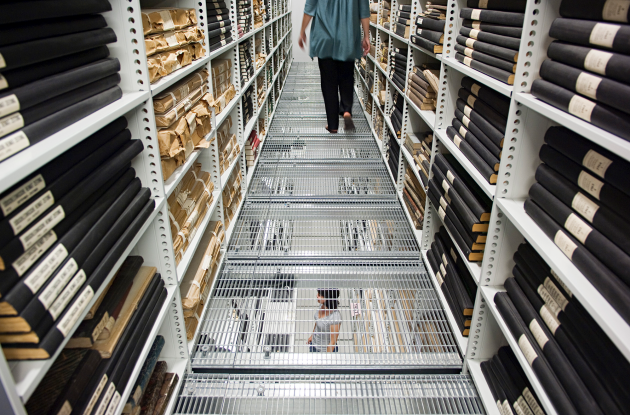Newspaper collection
The national newspaper collection consists of daily newspapers and local newspapers that have been published in Denmark or have direct relations to Denmark.

Photo: Thomas Søndergaard
For more than 300 years, newspapers have been an important part of society. They reflect all parts of our lives seen through the eyes of the people living at that time: birth and death, politics and economy, buying and selling, war and peace, accidents and progress.
For this reason, we now consider newspapers to be an important source for understanding our history, and they are a part of our cultural heritage that appeals to everyone, regardless if you are a genealogist, student, educator or just interested in local history.
The newspaper collection is Denmark’s national collection of newspapers and the main collection takes up 25 kilometres of shelving.
It is located in Skejby near Aarhus, where our focus is on collecting via legal deposit (printed and digital newspapers), and preserving printed newspapers in a secure building and digital newspapers on secure servers, and finally making the newspapers accessible by digitising and making them searchable on mediestream.dk.
The printed newspapers
The collection of physical newspapers is divided into two main categories: daily newspapers and local newspapers.
Daily newspapers make up 77 million pages and constitute around 5/6 of the collection The oldest newspapers are found in this part of our collection, such as Den Danske Mercurius from 1666.
There are around a thousand different newspapers that have been published in Denmark over time.
Local newspapers make up 15 million pages spread out on 3,700 titles, many of which are continuations of each other.
This type of newspaper became popular in the late 19th century and has grown over time to become an important part of the market for printed advertising and local information.
Further information about Danish newspapers
Reference books
- Jette D. Søllinge og Niels Thomsen: De danske aviser 1634-1991 (1991)
- Jette D. Søllinge: Lokalpressen - Danmarks lokale ugeaviser og distriktsblade 1850-2003 (2005)
- Ole C. Jørgensen: Beretningen om de danske aviser 1992-2011 (2016)
- Ole C. Jørgensen: Beretningen om de danske aviser 1992-2021 (2022)
- Avisårbogen 1924 ff.
Newspapers on microfilm
The preservation of newspapers was discussed as early as 1916: wear and tear, the fragile paper and how to preserve them for posterity. In 1955, the State and University Library entered an agreement with the company Minerva microfilm about microfilming a few select major newspapers.
From 1976-2015, all published newspapers of that time were continuously microfilmed in a division of labour between the National Library and Minerva Microfilm. In addition, a broad range of old newspapers were microfilmed for a special retro programme. In general, only daily newspapers were microfilmed, local newspapers were not.
For many years, microfilms were the user's best tools for research, both in public and research libraries. In 2005, Minerva was shut down and the job was taken over by the library.
Microfilming stopped in 2016 and was replaced by digital scanners. The microfilms at Royal Danish Library are however still available for use.